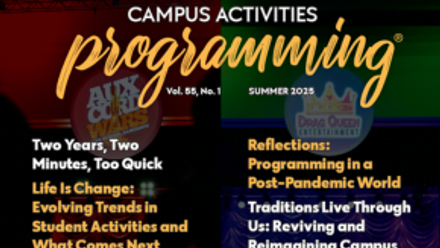Leadership Development Through Campus Employment: Preparing A New Workforce - JCAPS Vol. 1 Issue 2
Student employment is a key opportunity for student affairs practitioners to engage in leadership development. As the population of students seeking higher education shifts, now is the time for us to step forward fully and embrace our ability to enrich leadership development through the realm of student employment.
Over the past 25 years, higher education has seen an unprecedented expansion of access to students. According to the National Center for Educational Statistics, the number of students pursuing an education at colleges and universities has been steadily rising (2018). In 2015, fall enrollments at postsecondary institutions were up 23% over the levels just ten years prior. Much of this growth has come from historically underrepresented groups. From fall 1976 to fall 2015 the percentage of Hispanic students increased from 4% of college students to 17%. Gains among African Americans during this period were more modest, increasing from as low as 10% to as high as 15%. White students, who once made up as much as 84% of the total percentage of college students, made up about 58% of students during this timeframe (Snyder, DeBrey & Dillow, 2018).
This expansion in access carries with it the potential for economic prosperity. According to the U.S. Department of Education (2016), “Earning a college degree remains one of the most important investments one can make in his or her future. Over a lifetime, the average American with a bachelor’s degree will earn approximately $1 million more than those without any postsecondary education, [and] are… also far less likely to face unemployment” (New Federal Guidance, 2016, para. 1).
However, as Engstrom & Tinto stated in 2008, “Access without support is not opportunity,” which remains true for students today. Access to a college education alone does not mean equitable opportunities. Today the cost of a college education continues to rise, as college students work more hours than ever before to try to meet the gap in their ability to pay for school. The “Learning While Earning: The New Normal” report stated that more than 40% of undergraduate students work at least 30 hours each week and a quarter of all working students are both working and enrolled full time (Carnevale, Smith, Melton, & Price, 2015). With this changing landscape, past and present philosophies and strategies of education, training, and development - including approaches to student employment and opportunities for student development – no longer meet the realities of the student population and experiences of today. Now is the time for us as student affairs practitioners to respond to this gap.
Our opportunity is through student employment as a leadership development experience. Our educational institutions are poised to respond to these changing circumstances and to reimagine the value and the impact possible while developing students through this journey. We must carefully examine the pathways laid out to prepare students for graduation and successful entry into the workforce. Pathways must include interventions to support and retain students and to prepare them to navigate the world of work. To do this, both academic and student affairs practitioners will need to collaborate across disciplines, units, and departments, to think differently about how students learn, grow, and develop. The first step as practitioners is to learn more about the landscape of higher education, how the field is poised to respond to these challenges, and what and how interventions can be designed to serve students.






